Data Analysis Report: Age and Homelessness Relationship in the US
VerifiedAdded on 2023/05/27
|21
|2455
|198
Report
AI Summary
This report investigates the relationship between age and homelessness in the United States, utilizing data from the World Bank website from 2007 to 2014, with a focus on 2014. The study employs descriptive and correlational designs, including frequency analysis, correlation analysis, and regression analysis to determine the relationship between age and homelessness. Key variables such as total homeless, homeless individuals, homeless families, homeless young adults, and homeless youth and children are examined. The analysis reveals a significant number of homeless individuals, with a positive correlation between homeless individuals and the total homeless population. The regression analysis indicates that homeless individuals and families significantly contribute to the total homeless count. The study concludes that there are more homeless adults than children, and that age discrimination is a factor in homelessness. The report also tests hypotheses related to the relationship between homeless families and children, and the distribution of homeless persons across different age groups. The findings suggest that the issue of homelessness is a complex societal problem.
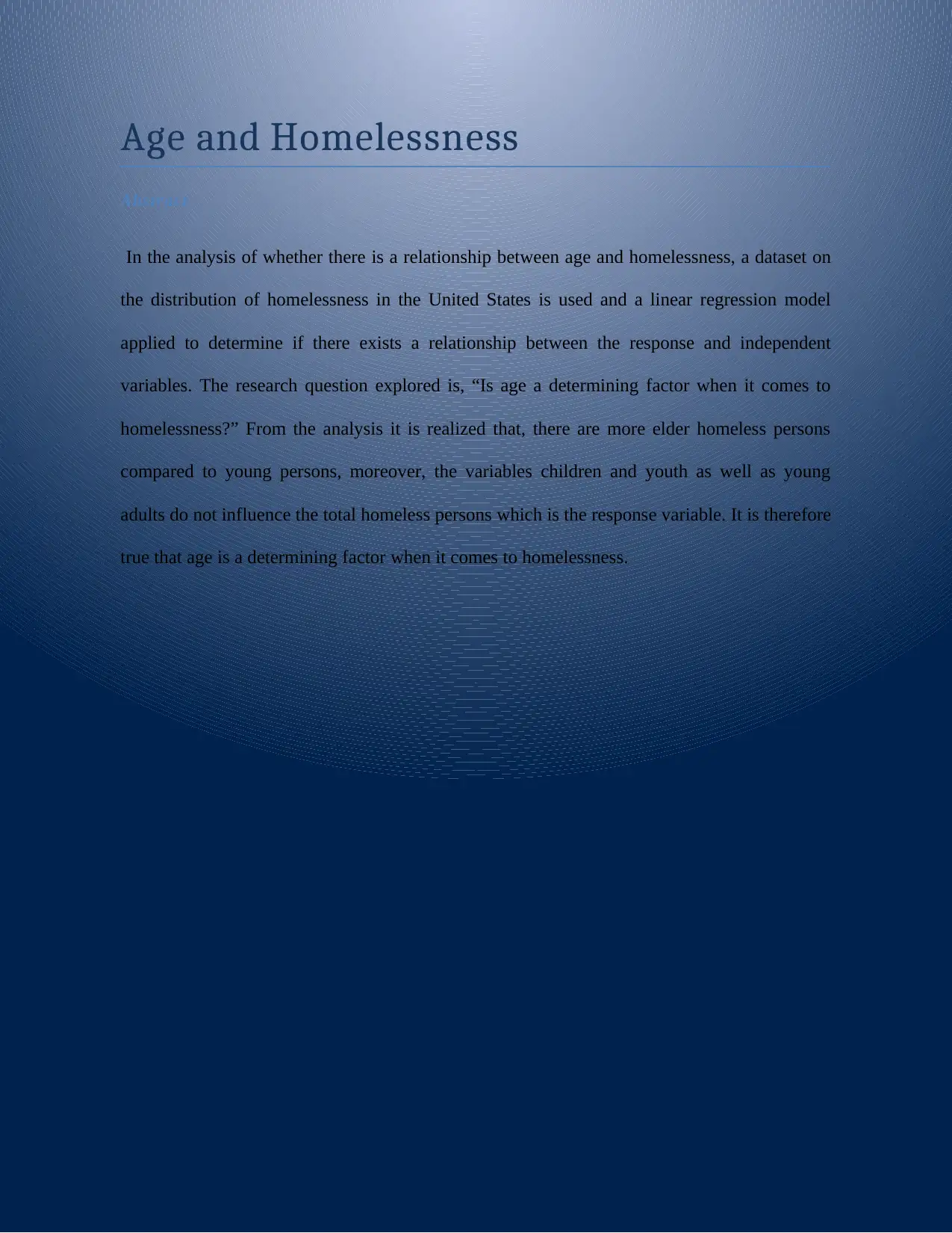
Age and Homelessness
Abstract
In the analysis of whether there is a relationship between age and homelessness, a dataset on
the distribution of homelessness in the United States is used and a linear regression model
applied to determine if there exists a relationship between the response and independent
variables. The research question explored is, “Is age a determining factor when it comes to
homelessness?” From the analysis it is realized that, there are more elder homeless persons
compared to young persons, moreover, the variables children and youth as well as young
adults do not influence the total homeless persons which is the response variable. It is therefore
true that age is a determining factor when it comes to homelessness.
Abstract
In the analysis of whether there is a relationship between age and homelessness, a dataset on
the distribution of homelessness in the United States is used and a linear regression model
applied to determine if there exists a relationship between the response and independent
variables. The research question explored is, “Is age a determining factor when it comes to
homelessness?” From the analysis it is realized that, there are more elder homeless persons
compared to young persons, moreover, the variables children and youth as well as young
adults do not influence the total homeless persons which is the response variable. It is therefore
true that age is a determining factor when it comes to homelessness.
Paraphrase This Document
Need a fresh take? Get an instant paraphrase of this document with our AI Paraphraser
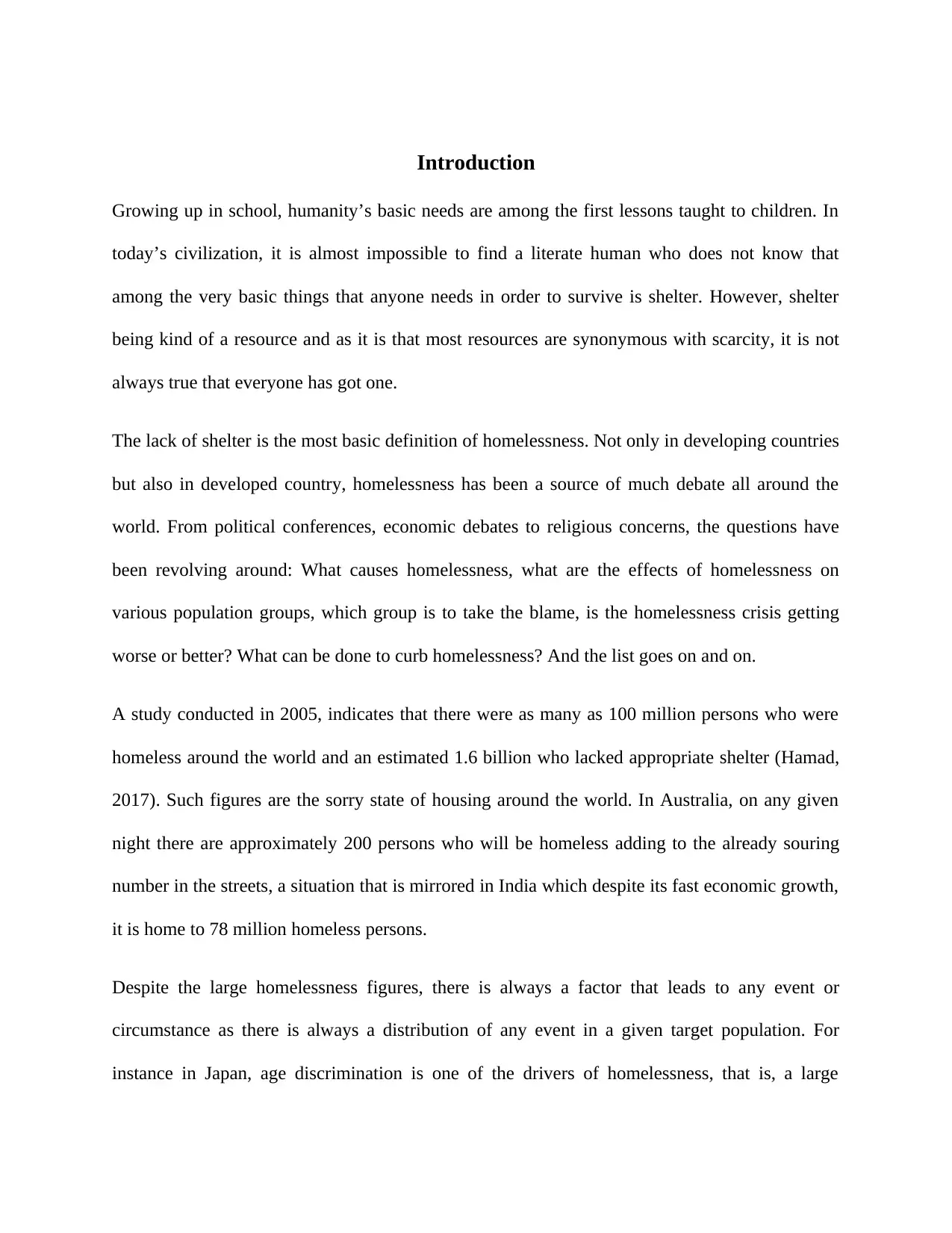
Introduction
Growing up in school, humanity’s basic needs are among the first lessons taught to children. In
today’s civilization, it is almost impossible to find a literate human who does not know that
among the very basic things that anyone needs in order to survive is shelter. However, shelter
being kind of a resource and as it is that most resources are synonymous with scarcity, it is not
always true that everyone has got one.
The lack of shelter is the most basic definition of homelessness. Not only in developing countries
but also in developed country, homelessness has been a source of much debate all around the
world. From political conferences, economic debates to religious concerns, the questions have
been revolving around: What causes homelessness, what are the effects of homelessness on
various population groups, which group is to take the blame, is the homelessness crisis getting
worse or better? What can be done to curb homelessness? And the list goes on and on.
A study conducted in 2005, indicates that there were as many as 100 million persons who were
homeless around the world and an estimated 1.6 billion who lacked appropriate shelter (Hamad,
2017). Such figures are the sorry state of housing around the world. In Australia, on any given
night there are approximately 200 persons who will be homeless adding to the already souring
number in the streets, a situation that is mirrored in India which despite its fast economic growth,
it is home to 78 million homeless persons.
Despite the large homelessness figures, there is always a factor that leads to any event or
circumstance as there is always a distribution of any event in a given target population. For
instance in Japan, age discrimination is one of the drivers of homelessness, that is, a large
Growing up in school, humanity’s basic needs are among the first lessons taught to children. In
today’s civilization, it is almost impossible to find a literate human who does not know that
among the very basic things that anyone needs in order to survive is shelter. However, shelter
being kind of a resource and as it is that most resources are synonymous with scarcity, it is not
always true that everyone has got one.
The lack of shelter is the most basic definition of homelessness. Not only in developing countries
but also in developed country, homelessness has been a source of much debate all around the
world. From political conferences, economic debates to religious concerns, the questions have
been revolving around: What causes homelessness, what are the effects of homelessness on
various population groups, which group is to take the blame, is the homelessness crisis getting
worse or better? What can be done to curb homelessness? And the list goes on and on.
A study conducted in 2005, indicates that there were as many as 100 million persons who were
homeless around the world and an estimated 1.6 billion who lacked appropriate shelter (Hamad,
2017). Such figures are the sorry state of housing around the world. In Australia, on any given
night there are approximately 200 persons who will be homeless adding to the already souring
number in the streets, a situation that is mirrored in India which despite its fast economic growth,
it is home to 78 million homeless persons.
Despite the large homelessness figures, there is always a factor that leads to any event or
circumstance as there is always a distribution of any event in a given target population. For
instance in Japan, age discrimination is one of the drivers of homelessness, that is, a large
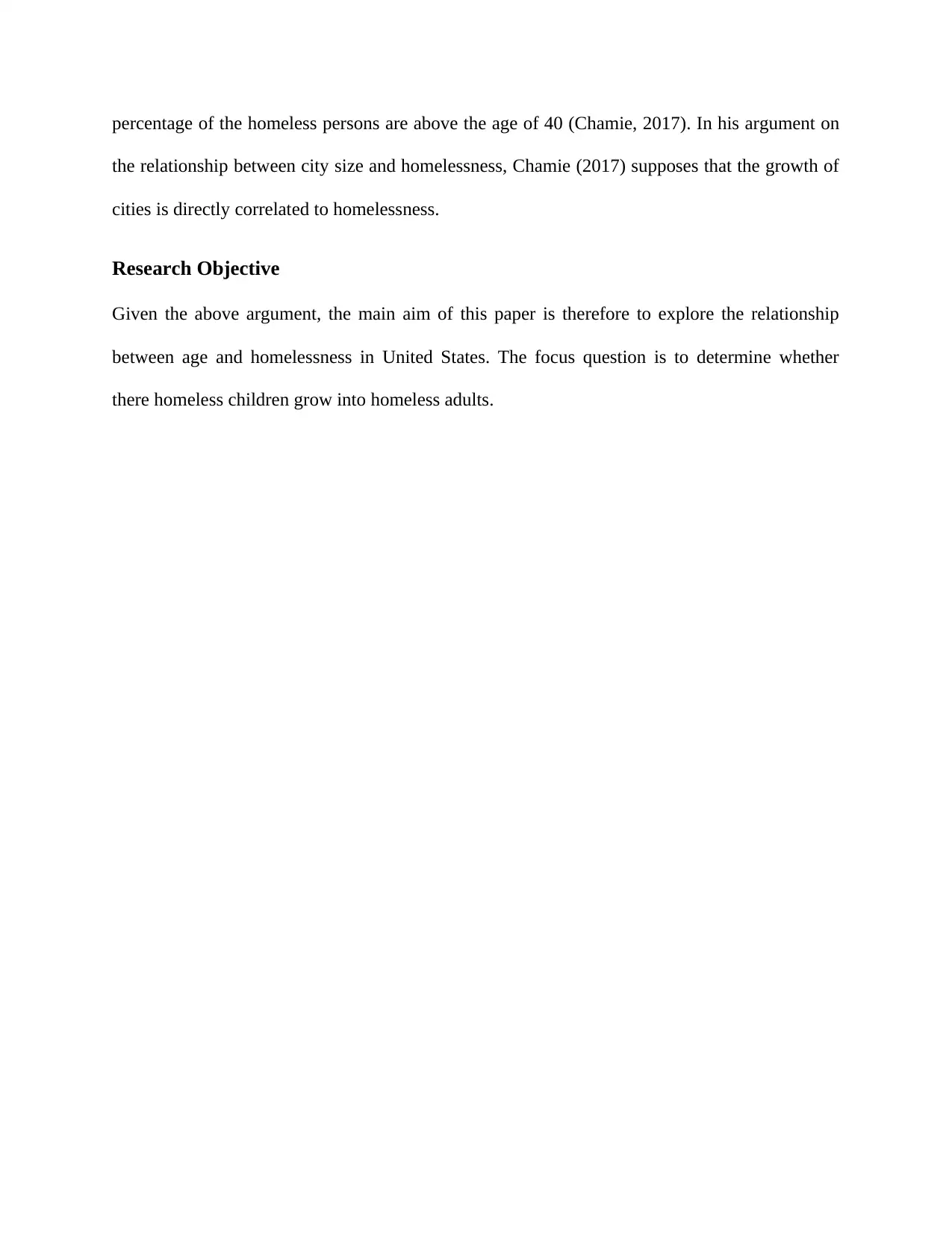
percentage of the homeless persons are above the age of 40 (Chamie, 2017). In his argument on
the relationship between city size and homelessness, Chamie (2017) supposes that the growth of
cities is directly correlated to homelessness.
Research Objective
Given the above argument, the main aim of this paper is therefore to explore the relationship
between age and homelessness in United States. The focus question is to determine whether
there homeless children grow into homeless adults.
the relationship between city size and homelessness, Chamie (2017) supposes that the growth of
cities is directly correlated to homelessness.
Research Objective
Given the above argument, the main aim of this paper is therefore to explore the relationship
between age and homelessness in United States. The focus question is to determine whether
there homeless children grow into homeless adults.
⊘ This is a preview!⊘
Do you want full access?
Subscribe today to unlock all pages.

Trusted by 1+ million students worldwide
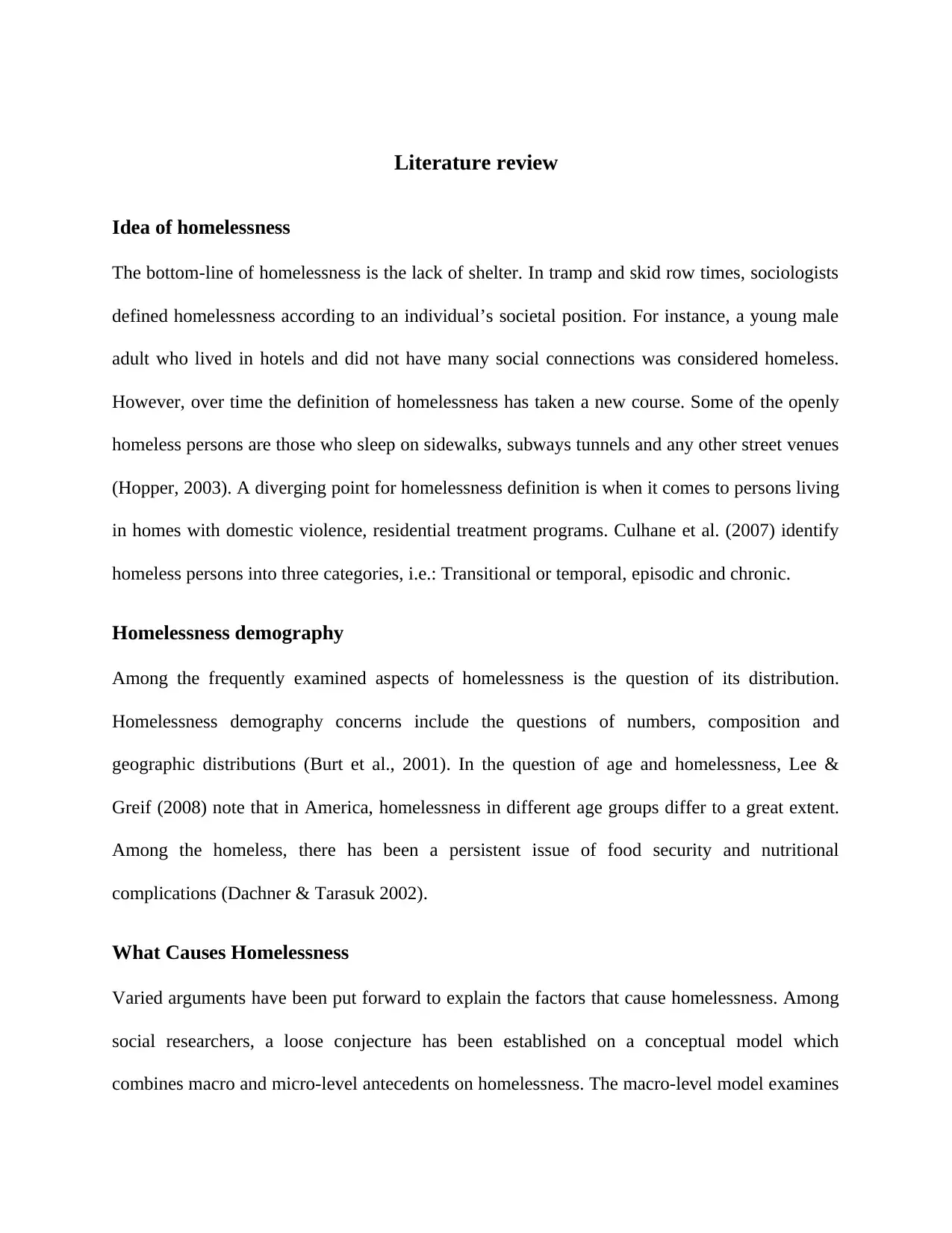
Literature review
Idea of homelessness
The bottom-line of homelessness is the lack of shelter. In tramp and skid row times, sociologists
defined homelessness according to an individual’s societal position. For instance, a young male
adult who lived in hotels and did not have many social connections was considered homeless.
However, over time the definition of homelessness has taken a new course. Some of the openly
homeless persons are those who sleep on sidewalks, subways tunnels and any other street venues
(Hopper, 2003). A diverging point for homelessness definition is when it comes to persons living
in homes with domestic violence, residential treatment programs. Culhane et al. (2007) identify
homeless persons into three categories, i.e.: Transitional or temporal, episodic and chronic.
Homelessness demography
Among the frequently examined aspects of homelessness is the question of its distribution.
Homelessness demography concerns include the questions of numbers, composition and
geographic distributions (Burt et al., 2001). In the question of age and homelessness, Lee &
Greif (2008) note that in America, homelessness in different age groups differ to a great extent.
Among the homeless, there has been a persistent issue of food security and nutritional
complications (Dachner & Tarasuk 2002).
What Causes Homelessness
Varied arguments have been put forward to explain the factors that cause homelessness. Among
social researchers, a loose conjecture has been established on a conceptual model which
combines macro and micro-level antecedents on homelessness. The macro-level model examines
Idea of homelessness
The bottom-line of homelessness is the lack of shelter. In tramp and skid row times, sociologists
defined homelessness according to an individual’s societal position. For instance, a young male
adult who lived in hotels and did not have many social connections was considered homeless.
However, over time the definition of homelessness has taken a new course. Some of the openly
homeless persons are those who sleep on sidewalks, subways tunnels and any other street venues
(Hopper, 2003). A diverging point for homelessness definition is when it comes to persons living
in homes with domestic violence, residential treatment programs. Culhane et al. (2007) identify
homeless persons into three categories, i.e.: Transitional or temporal, episodic and chronic.
Homelessness demography
Among the frequently examined aspects of homelessness is the question of its distribution.
Homelessness demography concerns include the questions of numbers, composition and
geographic distributions (Burt et al., 2001). In the question of age and homelessness, Lee &
Greif (2008) note that in America, homelessness in different age groups differ to a great extent.
Among the homeless, there has been a persistent issue of food security and nutritional
complications (Dachner & Tarasuk 2002).
What Causes Homelessness
Varied arguments have been put forward to explain the factors that cause homelessness. Among
social researchers, a loose conjecture has been established on a conceptual model which
combines macro and micro-level antecedents on homelessness. The macro-level model examines
Paraphrase This Document
Need a fresh take? Get an instant paraphrase of this document with our AI Paraphraser
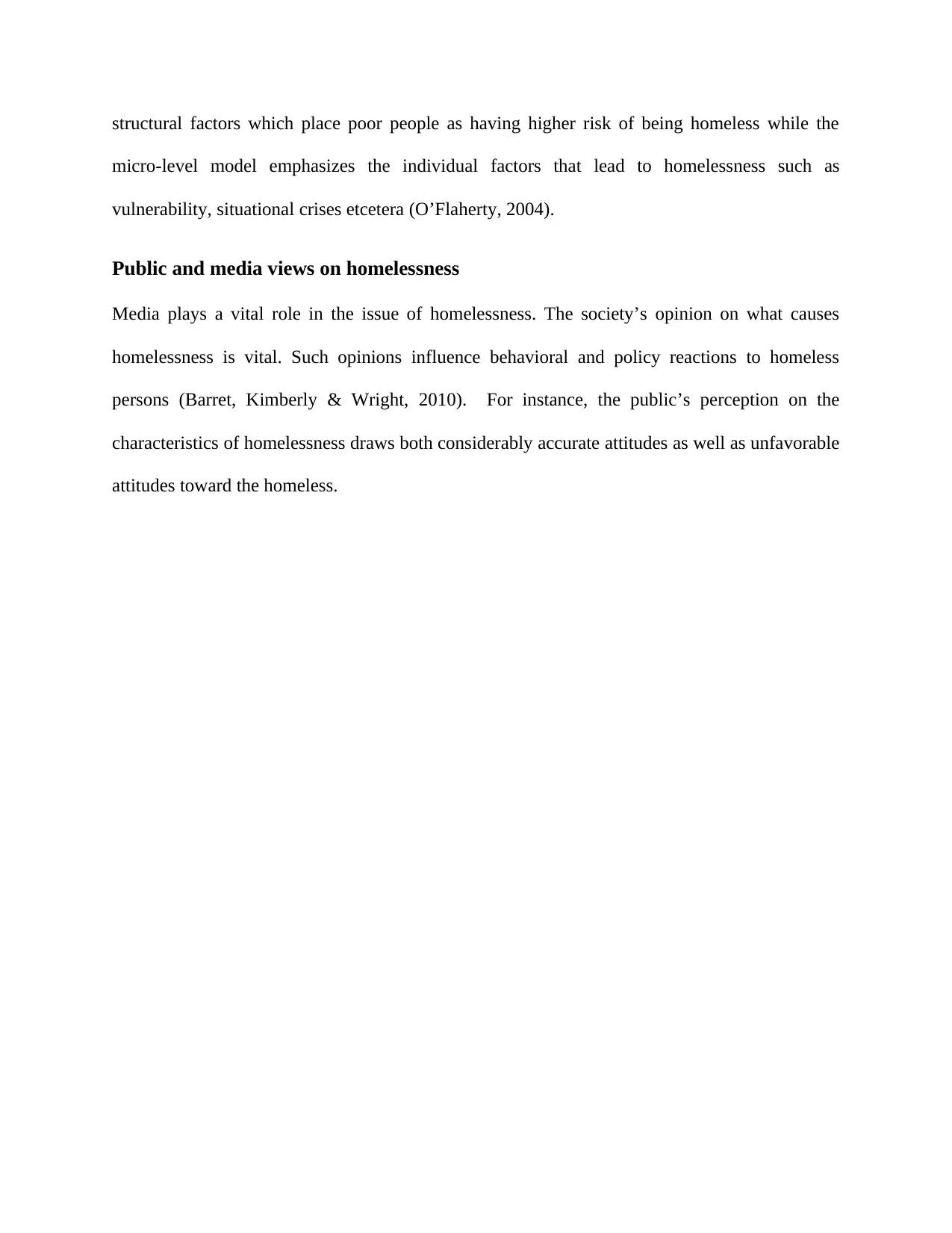
structural factors which place poor people as having higher risk of being homeless while the
micro-level model emphasizes the individual factors that lead to homelessness such as
vulnerability, situational crises etcetera (O’Flaherty, 2004).
Public and media views on homelessness
Media plays a vital role in the issue of homelessness. The society’s opinion on what causes
homelessness is vital. Such opinions influence behavioral and policy reactions to homeless
persons (Barret, Kimberly & Wright, 2010). For instance, the public’s perception on the
characteristics of homelessness draws both considerably accurate attitudes as well as unfavorable
attitudes toward the homeless.
micro-level model emphasizes the individual factors that lead to homelessness such as
vulnerability, situational crises etcetera (O’Flaherty, 2004).
Public and media views on homelessness
Media plays a vital role in the issue of homelessness. The society’s opinion on what causes
homelessness is vital. Such opinions influence behavioral and policy reactions to homeless
persons (Barret, Kimberly & Wright, 2010). For instance, the public’s perception on the
characteristics of homelessness draws both considerably accurate attitudes as well as unfavorable
attitudes toward the homeless.
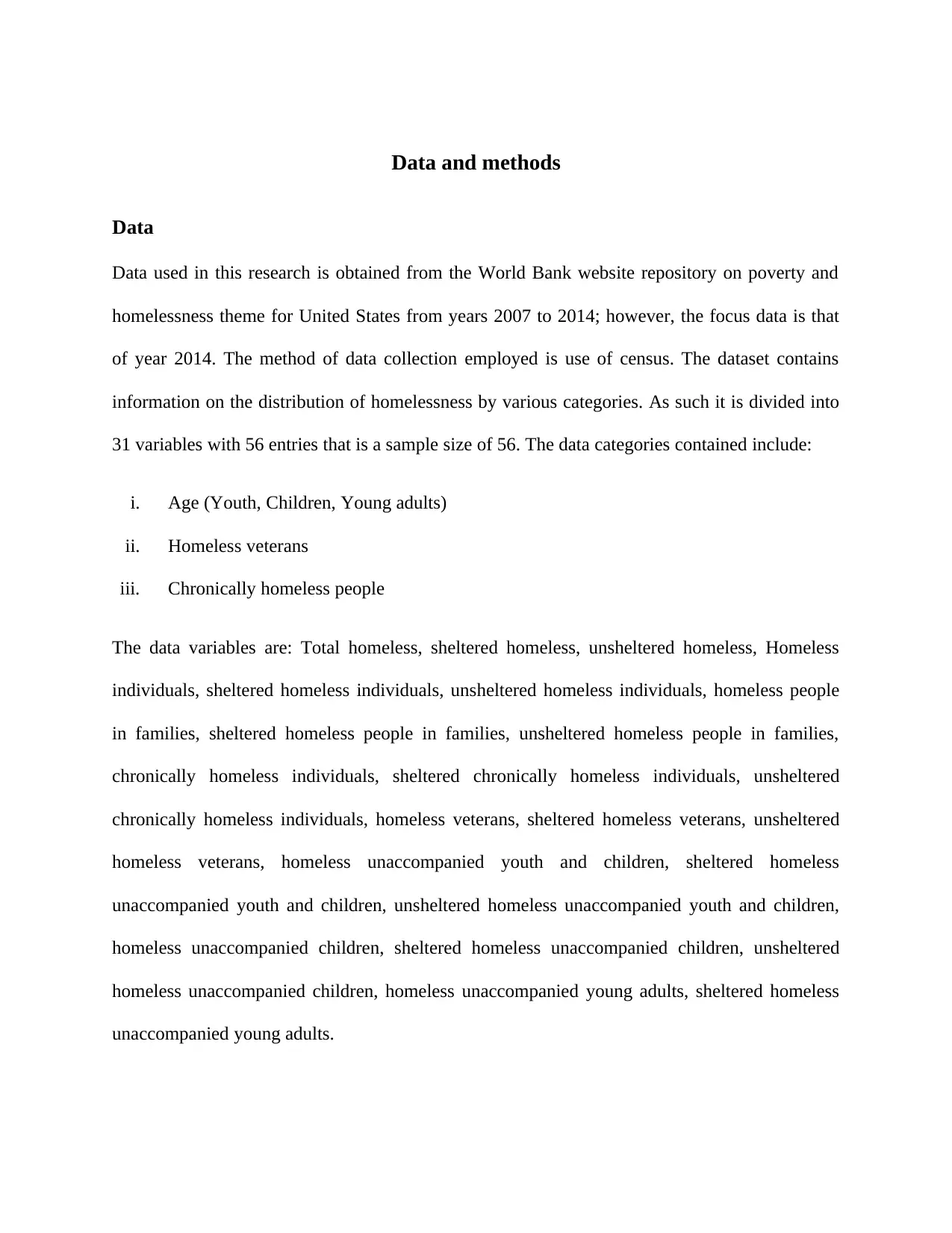
Data and methods
Data
Data used in this research is obtained from the World Bank website repository on poverty and
homelessness theme for United States from years 2007 to 2014; however, the focus data is that
of year 2014. The method of data collection employed is use of census. The dataset contains
information on the distribution of homelessness by various categories. As such it is divided into
31 variables with 56 entries that is a sample size of 56. The data categories contained include:
i. Age (Youth, Children, Young adults)
ii. Homeless veterans
iii. Chronically homeless people
The data variables are: Total homeless, sheltered homeless, unsheltered homeless, Homeless
individuals, sheltered homeless individuals, unsheltered homeless individuals, homeless people
in families, sheltered homeless people in families, unsheltered homeless people in families,
chronically homeless individuals, sheltered chronically homeless individuals, unsheltered
chronically homeless individuals, homeless veterans, sheltered homeless veterans, unsheltered
homeless veterans, homeless unaccompanied youth and children, sheltered homeless
unaccompanied youth and children, unsheltered homeless unaccompanied youth and children,
homeless unaccompanied children, sheltered homeless unaccompanied children, unsheltered
homeless unaccompanied children, homeless unaccompanied young adults, sheltered homeless
unaccompanied young adults.
Data
Data used in this research is obtained from the World Bank website repository on poverty and
homelessness theme for United States from years 2007 to 2014; however, the focus data is that
of year 2014. The method of data collection employed is use of census. The dataset contains
information on the distribution of homelessness by various categories. As such it is divided into
31 variables with 56 entries that is a sample size of 56. The data categories contained include:
i. Age (Youth, Children, Young adults)
ii. Homeless veterans
iii. Chronically homeless people
The data variables are: Total homeless, sheltered homeless, unsheltered homeless, Homeless
individuals, sheltered homeless individuals, unsheltered homeless individuals, homeless people
in families, sheltered homeless people in families, unsheltered homeless people in families,
chronically homeless individuals, sheltered chronically homeless individuals, unsheltered
chronically homeless individuals, homeless veterans, sheltered homeless veterans, unsheltered
homeless veterans, homeless unaccompanied youth and children, sheltered homeless
unaccompanied youth and children, unsheltered homeless unaccompanied youth and children,
homeless unaccompanied children, sheltered homeless unaccompanied children, unsheltered
homeless unaccompanied children, homeless unaccompanied young adults, sheltered homeless
unaccompanied young adults.
⊘ This is a preview!⊘
Do you want full access?
Subscribe today to unlock all pages.

Trusted by 1+ million students worldwide
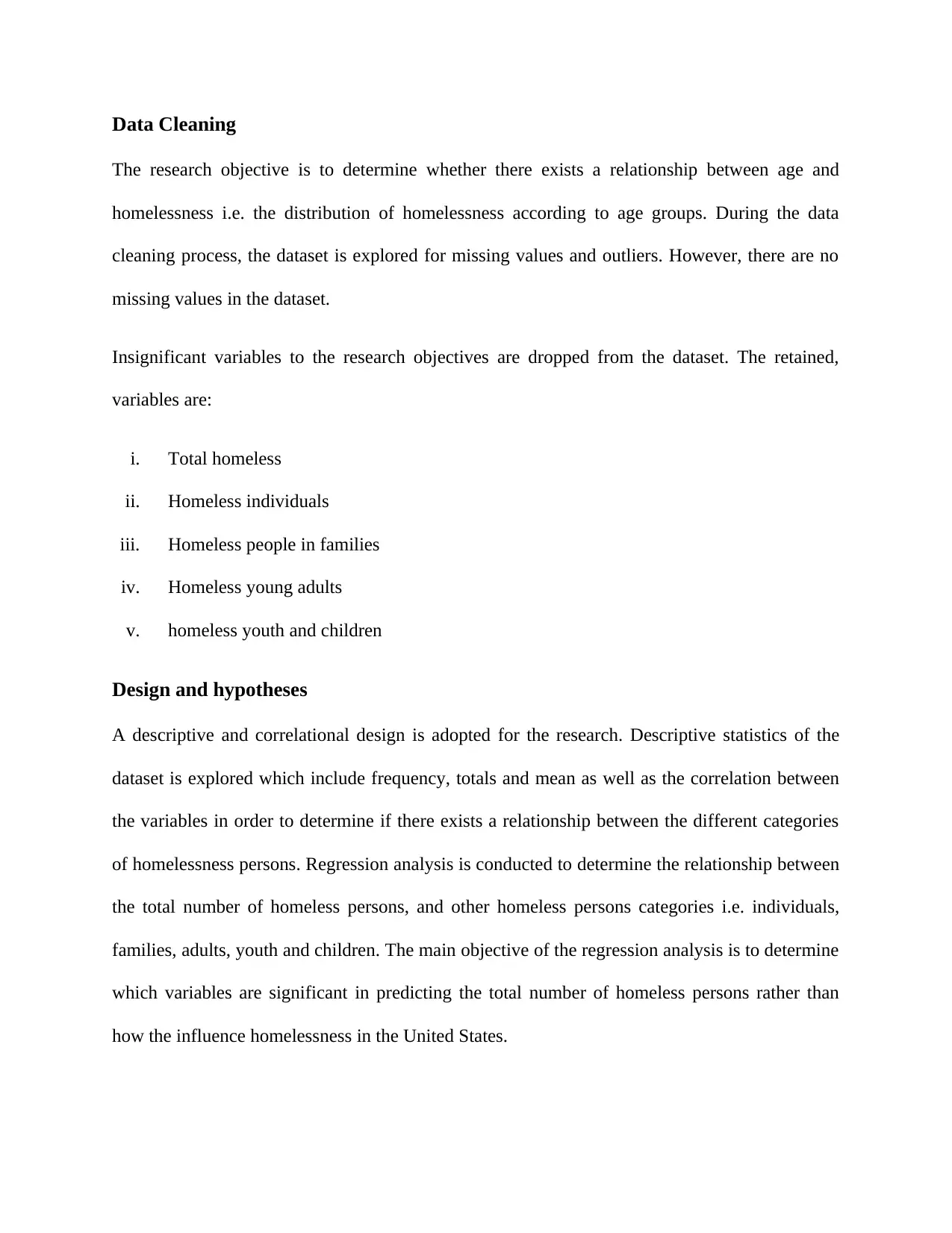
Data Cleaning
The research objective is to determine whether there exists a relationship between age and
homelessness i.e. the distribution of homelessness according to age groups. During the data
cleaning process, the dataset is explored for missing values and outliers. However, there are no
missing values in the dataset.
Insignificant variables to the research objectives are dropped from the dataset. The retained,
variables are:
i. Total homeless
ii. Homeless individuals
iii. Homeless people in families
iv. Homeless young adults
v. homeless youth and children
Design and hypotheses
A descriptive and correlational design is adopted for the research. Descriptive statistics of the
dataset is explored which include frequency, totals and mean as well as the correlation between
the variables in order to determine if there exists a relationship between the different categories
of homelessness persons. Regression analysis is conducted to determine the relationship between
the total number of homeless persons, and other homeless persons categories i.e. individuals,
families, adults, youth and children. The main objective of the regression analysis is to determine
which variables are significant in predicting the total number of homeless persons rather than
how the influence homelessness in the United States.
The research objective is to determine whether there exists a relationship between age and
homelessness i.e. the distribution of homelessness according to age groups. During the data
cleaning process, the dataset is explored for missing values and outliers. However, there are no
missing values in the dataset.
Insignificant variables to the research objectives are dropped from the dataset. The retained,
variables are:
i. Total homeless
ii. Homeless individuals
iii. Homeless people in families
iv. Homeless young adults
v. homeless youth and children
Design and hypotheses
A descriptive and correlational design is adopted for the research. Descriptive statistics of the
dataset is explored which include frequency, totals and mean as well as the correlation between
the variables in order to determine if there exists a relationship between the different categories
of homelessness persons. Regression analysis is conducted to determine the relationship between
the total number of homeless persons, and other homeless persons categories i.e. individuals,
families, adults, youth and children. The main objective of the regression analysis is to determine
which variables are significant in predicting the total number of homeless persons rather than
how the influence homelessness in the United States.
Paraphrase This Document
Need a fresh take? Get an instant paraphrase of this document with our AI Paraphraser
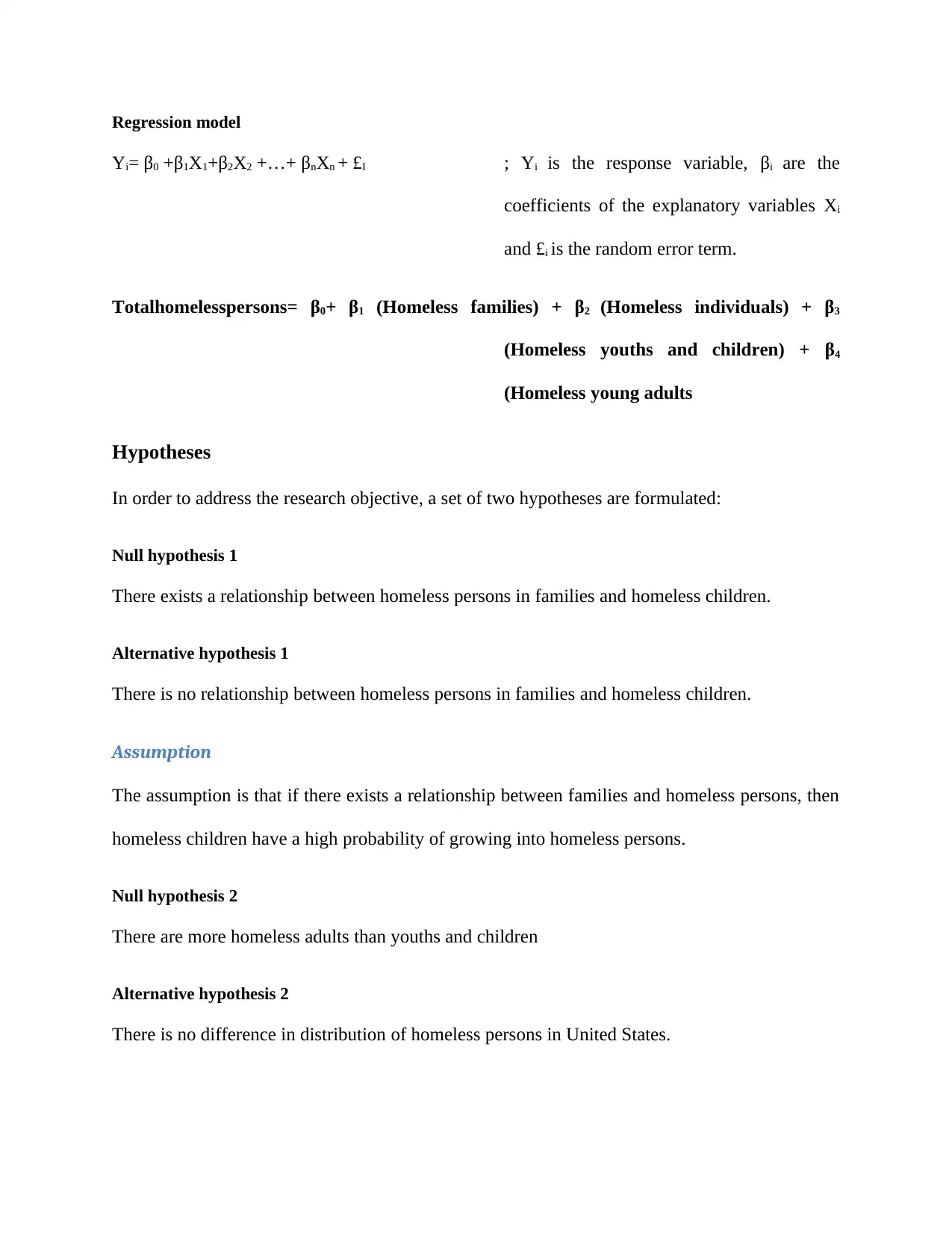
Regression model
Yi= β0 +β1X1+β2X2 +…+ βnXn + £I ; Yi is the response variable, βi are the
coefficients of the explanatory variables Xi
and £i is the random error term.
Totalhomelesspersons= β0+ β1 (Homeless families) + β2 (Homeless individuals) + β3
(Homeless youths and children) + β4
(Homeless young adults
Hypotheses
In order to address the research objective, a set of two hypotheses are formulated:
Null hypothesis 1
There exists a relationship between homeless persons in families and homeless children.
Alternative hypothesis 1
There is no relationship between homeless persons in families and homeless children.
Assumption
The assumption is that if there exists a relationship between families and homeless persons, then
homeless children have a high probability of growing into homeless persons.
Null hypothesis 2
There are more homeless adults than youths and children
Alternative hypothesis 2
There is no difference in distribution of homeless persons in United States.
Yi= β0 +β1X1+β2X2 +…+ βnXn + £I ; Yi is the response variable, βi are the
coefficients of the explanatory variables Xi
and £i is the random error term.
Totalhomelesspersons= β0+ β1 (Homeless families) + β2 (Homeless individuals) + β3
(Homeless youths and children) + β4
(Homeless young adults
Hypotheses
In order to address the research objective, a set of two hypotheses are formulated:
Null hypothesis 1
There exists a relationship between homeless persons in families and homeless children.
Alternative hypothesis 1
There is no relationship between homeless persons in families and homeless children.
Assumption
The assumption is that if there exists a relationship between families and homeless persons, then
homeless children have a high probability of growing into homeless persons.
Null hypothesis 2
There are more homeless adults than youths and children
Alternative hypothesis 2
There is no difference in distribution of homeless persons in United States.

⊘ This is a preview!⊘
Do you want full access?
Subscribe today to unlock all pages.

Trusted by 1+ million students worldwide
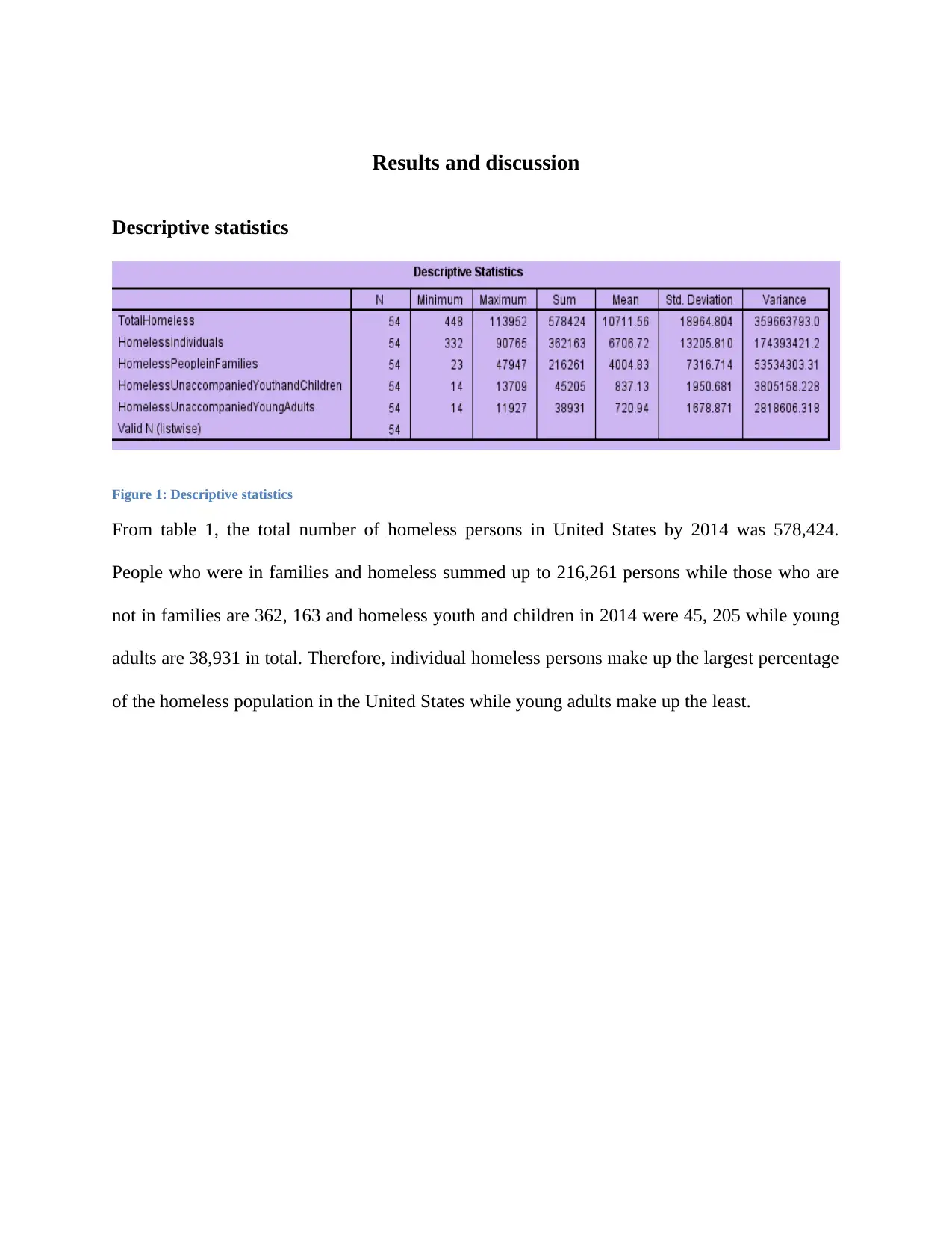
Results and discussion
Descriptive statistics
Figure 1: Descriptive statistics
From table 1, the total number of homeless persons in United States by 2014 was 578,424.
People who were in families and homeless summed up to 216,261 persons while those who are
not in families are 362, 163 and homeless youth and children in 2014 were 45, 205 while young
adults are 38,931 in total. Therefore, individual homeless persons make up the largest percentage
of the homeless population in the United States while young adults make up the least.
Descriptive statistics
Figure 1: Descriptive statistics
From table 1, the total number of homeless persons in United States by 2014 was 578,424.
People who were in families and homeless summed up to 216,261 persons while those who are
not in families are 362, 163 and homeless youth and children in 2014 were 45, 205 while young
adults are 38,931 in total. Therefore, individual homeless persons make up the largest percentage
of the homeless population in the United States while young adults make up the least.
Paraphrase This Document
Need a fresh take? Get an instant paraphrase of this document with our AI Paraphraser
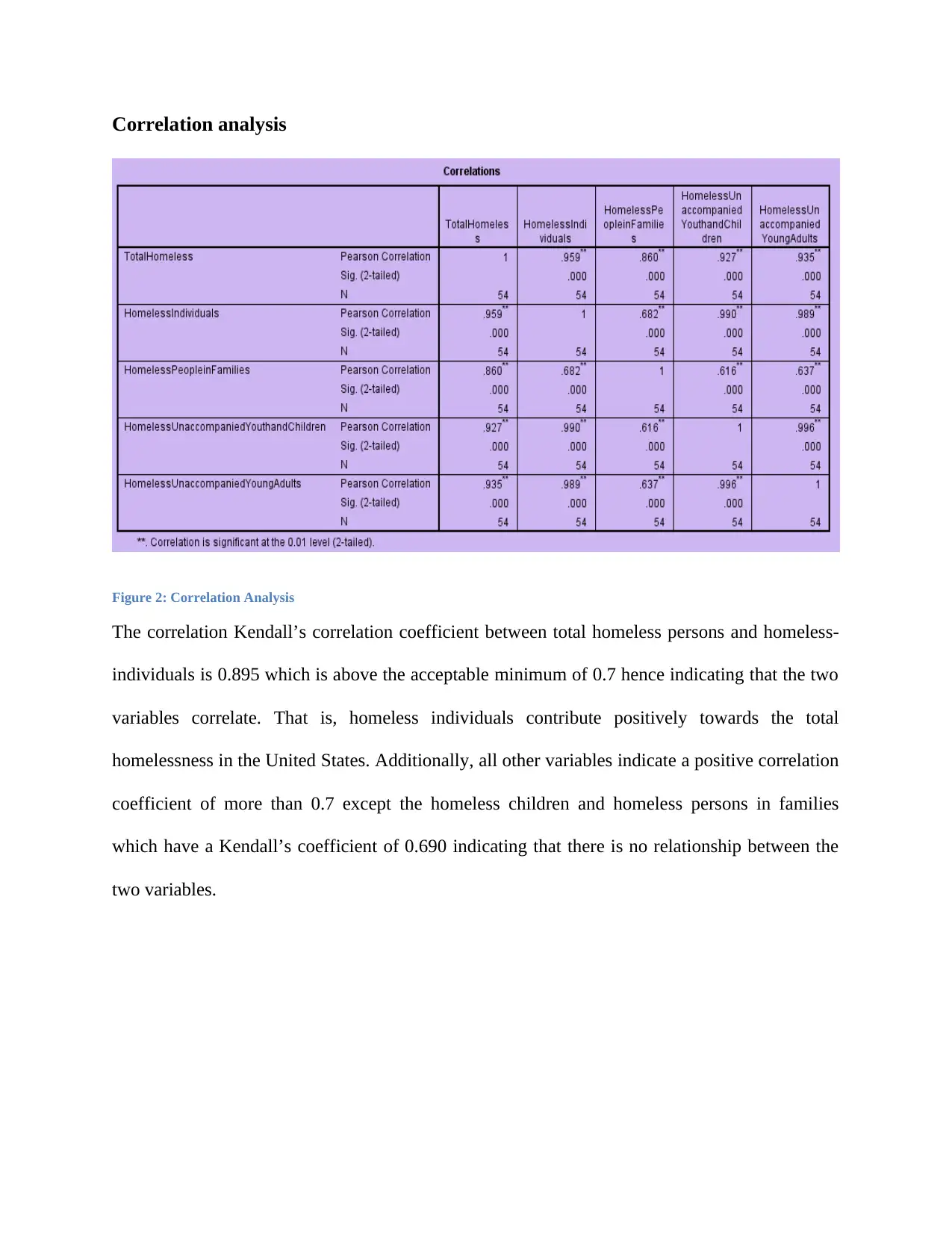
Correlation analysis
Figure 2: Correlation Analysis
The correlation Kendall’s correlation coefficient between total homeless persons and homeless-
individuals is 0.895 which is above the acceptable minimum of 0.7 hence indicating that the two
variables correlate. That is, homeless individuals contribute positively towards the total
homelessness in the United States. Additionally, all other variables indicate a positive correlation
coefficient of more than 0.7 except the homeless children and homeless persons in families
which have a Kendall’s coefficient of 0.690 indicating that there is no relationship between the
two variables.
Figure 2: Correlation Analysis
The correlation Kendall’s correlation coefficient between total homeless persons and homeless-
individuals is 0.895 which is above the acceptable minimum of 0.7 hence indicating that the two
variables correlate. That is, homeless individuals contribute positively towards the total
homelessness in the United States. Additionally, all other variables indicate a positive correlation
coefficient of more than 0.7 except the homeless children and homeless persons in families
which have a Kendall’s coefficient of 0.690 indicating that there is no relationship between the
two variables.
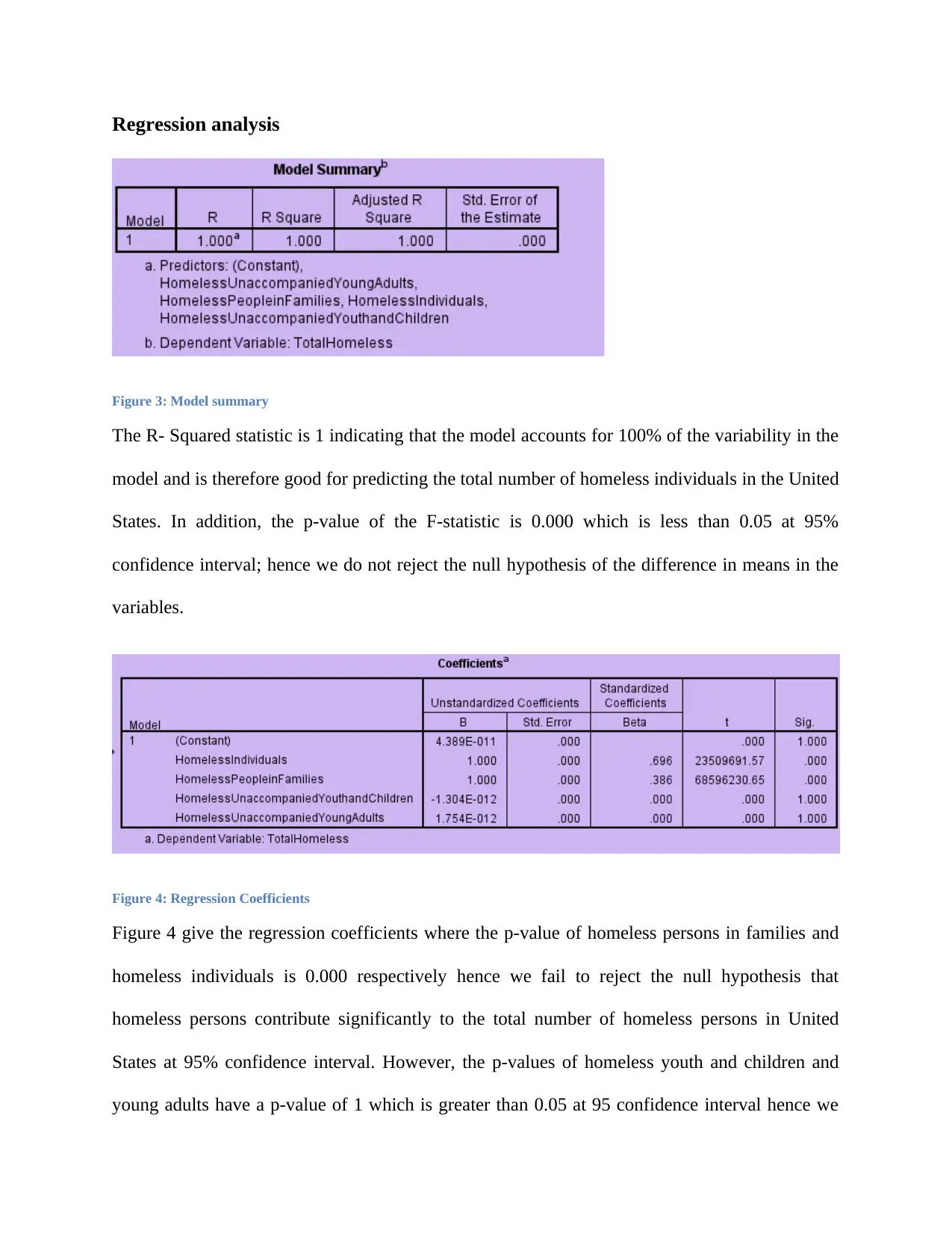
Regression analysis
Figure 3: Model summary
The R- Squared statistic is 1 indicating that the model accounts for 100% of the variability in the
model and is therefore good for predicting the total number of homeless individuals in the United
States. In addition, the p-value of the F-statistic is 0.000 which is less than 0.05 at 95%
confidence interval; hence we do not reject the null hypothesis of the difference in means in the
variables.
Figure 4: Regression Coefficients
Figure 4 give the regression coefficients where the p-value of homeless persons in families and
homeless individuals is 0.000 respectively hence we fail to reject the null hypothesis that
homeless persons contribute significantly to the total number of homeless persons in United
States at 95% confidence interval. However, the p-values of homeless youth and children and
young adults have a p-value of 1 which is greater than 0.05 at 95 confidence interval hence we
Figure 3: Model summary
The R- Squared statistic is 1 indicating that the model accounts for 100% of the variability in the
model and is therefore good for predicting the total number of homeless individuals in the United
States. In addition, the p-value of the F-statistic is 0.000 which is less than 0.05 at 95%
confidence interval; hence we do not reject the null hypothesis of the difference in means in the
variables.
Figure 4: Regression Coefficients
Figure 4 give the regression coefficients where the p-value of homeless persons in families and
homeless individuals is 0.000 respectively hence we fail to reject the null hypothesis that
homeless persons contribute significantly to the total number of homeless persons in United
States at 95% confidence interval. However, the p-values of homeless youth and children and
young adults have a p-value of 1 which is greater than 0.05 at 95 confidence interval hence we
⊘ This is a preview!⊘
Do you want full access?
Subscribe today to unlock all pages.

Trusted by 1+ million students worldwide
1 out of 21
Your All-in-One AI-Powered Toolkit for Academic Success.
+13062052269
info@desklib.com
Available 24*7 on WhatsApp / Email
![[object Object]](/_next/static/media/star-bottom.7253800d.svg)
Unlock your academic potential
Copyright © 2020–2025 A2Z Services. All Rights Reserved. Developed and managed by ZUCOL.


